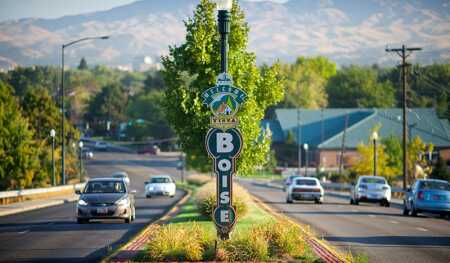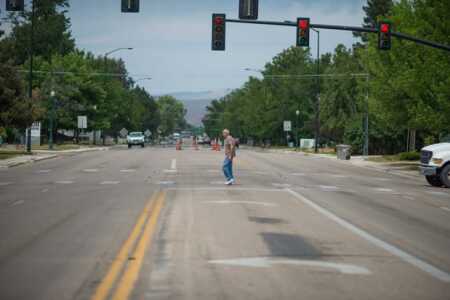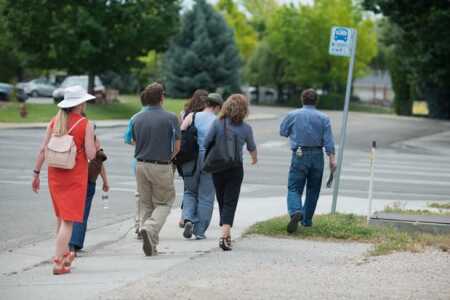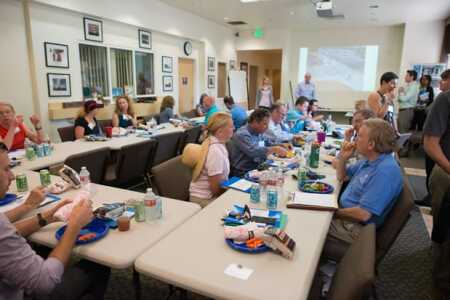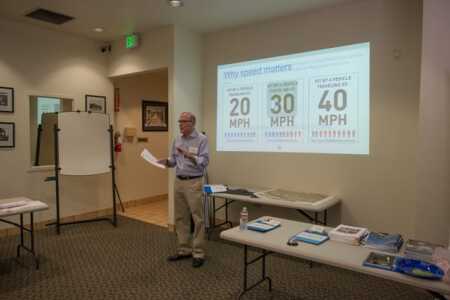Bill Freeman sets out for his morning strolls early. The avid Boise, Idaho, walker strategically navigates the city’s north Vista Avenue corridor, avoiding certain difficult intersections. He lives just blocks away from Vista Avenue and likes that he is within walking distance of shops, restaurants, banks, and other services. But his walk does not come without risk—especially if it involves a crossing from the west to the south side of one of the street’s busiest intersections with Overland Road, a remnant of the historic Oregon Trail.
“There’s no direct path to the other side,” he says, noting a left-hand lane that merges with Overland Road without crosswalk or stop signs. “If I go to the bank, sometimes I wait until there’s no traffic and just jaywalk across,” Freeman says. “I know I should use a crosswalk. I can follow the rules if I have to, but sometimes it’s just easier.”
On a hot day in June, Freeman stood as a lone pedestrian on the corridor’s four-mile (6.4 km) route from the airport to downtown Boise. Other pedestrians choose other routes, opting to walk or ride on quiet blocks to the east and west of the main street, avoiding the avenue’s sun-parched sidewalks and narrow shoulders.
The once sagebrush-studded corridor guided Oregon Trail pioneers from a dusty desert trek down a hill to the cool banks of the Boise River. A sweeping landscape of the Rockies, mountain foothills, and the cottonwood-lined river valley below welcomed the travelers with a view that gave rise to the namesake of today’s busy commuter route. Today, the four-lane arterial that is Vista Avenue connects a youthful, bustling downtown and university district to the city’s airport.
Ben Quintana, a member of Boise’s city council, wants to see Vista Avenue match the vitality and livability that attracted generations of transplants to the emerging urban hotspot and which retains long-term residents. He was joined in this endeavor when he participated in June in ULI’s Vista Avenue Healthy Corridor workshop along with other local stakeholders. The hope is that ideas that arose from the workshop could eventually change Bill Freeman’s daily walks—and improve such corridors across the country. “This is going to be a great starting point to show others what’s possible when the community actually partners together to make change happen,” Quintana says.
“It just takes time; it doesn’t happen overnight,” says Dave Kangas, president of the Vista Neighborhood Association and a real estate agent in Boise.
Vista with No View
The once-vast view of western landscape along Vista Avenue is all but gone now, hidden behind walls of single-story buildings, oversized signs, and trees. Just slivers of the old view are visible through the elevated beginning and end of the corridor today.
Kangas says the local political will exists to make change happen. He sees an opportunity to turn the Vista area into the kind of place he knew as a kid growing up nearby in the 1960s. He remembers a farmhouse that lent Vista Avenue a rural feel that beckoned kids outside to play. But Kangas does not want to turn back the clock completely, noting that the area’s quick city access, proximity to shops, and affordable real estate make the area a gem for first-time homebuyers. But he would like to see the street become safer and more inviting for pedestrians.
Grants from the Robert Wood Johnson Foundation and the Colorado Health Foundation are enabling ULI’s Healthy Corridors project to investigate best practices that will transform under-performing corridors into health-promoting places for the people who live, work, and travel along them.
ULI’s Healthy Corridors work begins with an examination of Boise’s Vista Avenue, along with three other corridors in Los Angeles, California; Denver, Colorado; and Nashville, Tennessee. Lessons learned from the two-year project’s demonstration corridors will help shape planning decisions across the country as communities grapple with how to solve the problems of urban and suburban arterials. Those lessons began to emerge at the Vista workshop that gave community stakeholders a chance to dissect the street, diagnose its ills, and imagine remedies that can lead to a healthier future. The Boise effort is being chaired by longtime ULI member Bob Taunton.
“This project is lifting up the idea that you can use health, healthy people, and healthy communities as a core value for reinventing these places,” says ULI senior vice president Rachel MacCleery, who manages the Building Healthy Places Initiative.
She notes that many chronic health problems stem from an unhealthy environment that keeps people from easily accessing healthy food, safe pedestrian routes, and clean streets. Many of the nation’s arterial corridors are dirty, dangerous, and dismal, she says, pointing to the 200-plus accidents that occurred along Vista Avenue between 2011 and 2013.
“When you start thinking about health . . . you start thinking very carefully about infrastructure and social connections and social cohesion. And health really provides a powerful lens to rethink what these places can and should be,” MacCleery says.
And economic revitalization can naturally grow out of healthy communities. When people enjoy the aesthetics of their environment and feel safe, they are more likely to stick around, says Ed McMahon, one of the Institute’s senior resident fellows. Those environments, which he calls “real neighborhoods,” usually have multiple entry points, bike lanes, sidewalks, parks, gardens, shade trees, and crosswalks—everything that workshop attendees found in short supply along Vista Avenue.
“When you get to a real neighborhood, people stay longer, they come back more often, and they spend more money because it’s a place they like to be,” McMahon says.
Anywhere, U.S.A.
McMahon projected a photograph of an urban corridor on a screen for workshop participants and asked them to name the place. Attendees, including city planners, commercial landlords, and health district officials, started guessing locations for the photo, which displayed a tangle of massive signs, neon lights, utility wires, and bland building facades. “I’ll tell you where it is. That’s ‘Anywhere, U.S.A.,’ ” said McMahon. He asked participants to name what’s wrong with the photos. “There are no trees,” one said. Jaywalkers, clutter, and absent turn lanes also grabbed their attention.
“It’s ugly, it’s unsafe, it’s unhealthy, it’s unwalkable, it’s underperforming economically, and it’s not connected to anything,” McMahon said. “Corridors are one of our biggest reinvestment opportunities,” he noted.
Workshop participants toured Vista Avenue on foot, searching for signs of opportunity. The avenue is a path that many participants drive on a daily basis, but nearly all of them said that the workshop helped them see their own backyard a little differently.
“There’s something magical that happens when you actually put yourself in the shoes of the people you’re trying to help,” Quintana says. “We got to not only see the neighborhood, we got to feel what it was like to walk down the street and it helped us understand how we would like to see things change.”
Stakeholders returned from their exploration with lists of ideas about how the community could reinvent the corridor with an eye on the street’s existing assets and biggest obstacles.
“I was really pleased to see that Boise has so many well-thinking and sincere people to go through this process,” said Donna Day Jacobs, who manages the Vista Village shopping center. “They’re willing to do the research and understand the process.”
She says she hopes the research that comes from the Healthy Corridors project can help businesses solve some enduring problems—namely, how to manage traffic and keep shops accessible to a range of customers. She wants to see the collaborative efforts lead to ways to make pedestrians, cars, and businesses coexist in a safe and healthy way. “I’m interested in the new energy that will solve this problem differently,” she says.
Nearly every participant pointed to the challenge of finding the resources to implement changes, while they almost universally share a common wish list that includes boosting the aesthetics of the area with landscaping and better sidewalks. A lack of accessibility, few green spaces, and nonexistent bike lanes are high among participants’ priorities.
“We could put a lot of money into making things prettier, and we should do it,” Day Jacobs said.
Kangas noted opportunities for dividing sidewalks and reappropriating unused parking space. AnaMarie Guiles, manager of the city’s department of housing and development, came away from the workshop seeing the ability to implement some economical quick fixes by installing bus shelters, abating weeds, and enforcing codes.
And Quintana returned with a more pedestrian-oriented view that he says he plans to take to the city council. That view puts him in the shoes of Bill Freeman. “The feeling you get when you have to walk down the street when a dump truck or others cars are going by at 35 or sometimes 40 miles an hour . . . is so unsafe,” Quintana says. “Then try and imagine how that feels for a young family or someone who might use a wheelchair.”
Carissa Wolf is a freelance writer.

